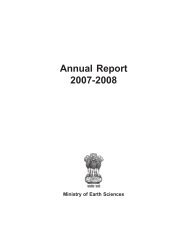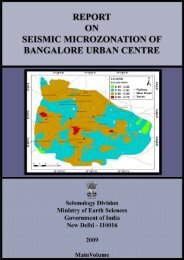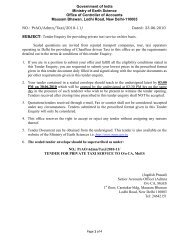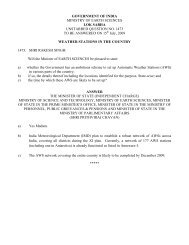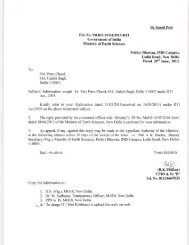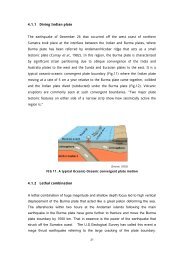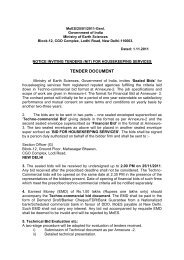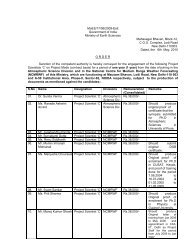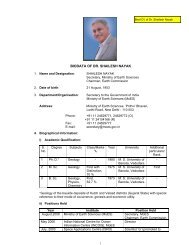Annual Report 2009-2010 - Ministry Of Earth Sciences
Annual Report 2009-2010 - Ministry Of Earth Sciences
Annual Report 2009-2010 - Ministry Of Earth Sciences
Create successful ePaper yourself
Turn your PDF publications into a flip-book with our unique Google optimized e-Paper software.
• Fog monitoring and forecasting service for IGI<br />
Airport was provided on IMD’s website where<br />
current visibility and Runway Visual Range<br />
along with two hourly trend forecast was made<br />
available for users.<br />
2.8 Location Specific Forecast<br />
The System of Air Quality Forecasting and<br />
Research (SAFAR) for Air Quality Forecasting<br />
for Commonwealth Games (CWG) is being<br />
accomplished for the first time in India along<br />
with establishing forecast and nowcast system for<br />
the Games through commissioning of Automatic<br />
Weather Stations, Doppler Weather Radar and<br />
other observing systems that will provide forecast<br />
products specific to venues. The entire system will<br />
provide and display the information on weather<br />
and air quality on real time and forecast the future<br />
weather and level of pollution at various key<br />
locations (outdoor: 12 and indoor: 4) of CWG <strong>2010</strong><br />
through wireless true colour digital display panels.<br />
The real time and forecasting will include the air<br />
pollutants, e.g. Ozone, NOx, CO, PM 2.5<br />
, PM 10<br />
, Black<br />
Carbon and Benzene. In the recent past, only a<br />
few developed countries have demonstrated the<br />
strength to develop this kind of system during<br />
major games like during the Olympic Games in<br />
Beijing, China and Melbourne, Australia.<br />
World Meteorological Organization (WMO)<br />
through their programme Global Atmospheric<br />
Watch (GAW) Urban Research Meteorology and<br />
Environment (GURME) has recognised “SAFAR”<br />
as their pilot activity implying this effort is at<br />
par with international standard as stipulated<br />
by stringent scientific guidelines for confidence<br />
in quality control and quality assurance. This<br />
has also led MoES to represent Asian region in<br />
the Scientific Advisory Committee for Global<br />
Atmospheric Watch-Urban Research Meteorology<br />
and Environment (GAW-GURME).<br />
2.9 Environmental Monitoring<br />
The network for Air Pollution Monitoring<br />
comprises monitoring stations at Allahabad,<br />
Jodhpur, Kodaikanal, Minicoy, Mohanbari, Nagpur,<br />
Port Blair, Pune, Srinagar and Visakhapatnam that<br />
continue to collect rain samples for chemical<br />
analyses and measurement of atmospheric<br />
turbidity with the objective of documenting the<br />
long-term changes in composition of trace species<br />
of the atmosphere. The wet precipitation samples<br />
are analysed at Central Chemical Laboratory for<br />
pH, conductivity, major cations (Ca, Mg, Na, K,<br />
NH 4<br />
) and anions (SO 4<br />
, NO 3<br />
, Cl).<br />
Atmospheric Turbidity indicating the columnar<br />
aerosol load of the atmosphere continued to be<br />
measured at Allahabad, Jodhpur, Kodaikanal,<br />
Nagpur, Port Blair, Srinagar, Pune, Mohanbari,<br />
Minicoy and Visakhapatnam. These data provide<br />
reliable long-term observations of the chemical<br />
composition of the atmosphere and related<br />
parameters in order to improve understanding of<br />
atmospheric chemistry.<br />
Specific services pertaining to environment are<br />
rendered to the <strong>Ministry</strong> of Environment and<br />
Forests and other Government agencies in the<br />
assessment of likely air pollution impacts arising<br />
from thermal power generation, industries and<br />
mining activities. Atmospheric diffusion models<br />
developed for carrying out air quality impacts of<br />
multiple sources located in different climatic and<br />
geographical conditions are being utilised for<br />
siting of industries and adoption of air pollution<br />
control strategies.<br />
2.10 Satellite Meteorology<br />
2.10.1 INSAT Data Reception and Processing<br />
At present, IMD is receiving and processing<br />
meteorological data from two Indian satellites,<br />
namely Kalpana-1 at 74 ° E and INSAT-3A at<br />
93.5 ° E. At present, about 48 satellite images are<br />
taken daily from Kalpana-1 which is the main<br />
operational satellite and 9 images are taken<br />
from INSAT-3A. Imaging from CCD is done five<br />
times during daytime only. All the received data<br />
from the satellite is processed and archived<br />
in National Satellite Data Centre (NSDC),<br />
New Delhi.<br />
6 <strong>Ministry</strong> of <strong>Earth</strong> <strong>Sciences</strong> : <strong>Annual</strong> <strong>Report</strong> <strong>2009</strong>-10





